Featured Comment
This Authentic Homemade Japanese Miso Soup is amazing! I made it twice and my family loves it! A definite keeper, thank you for sharing and for the detailed instructions!
★★★★★
– Lisa
Alongside tuna sushi, tempura, shoyu ramen, udon noodle soup, and chicken yakitori, miso soup stands as one of Japan’s most iconic dishes, yet it’s often lost in translation.
Here you’ll learn the timeless home-style method with dashi stock at its core. Once mastered, you can craft your own! Whether mushroom miso soup, salmon miso soup, or countless other miso soup variations.
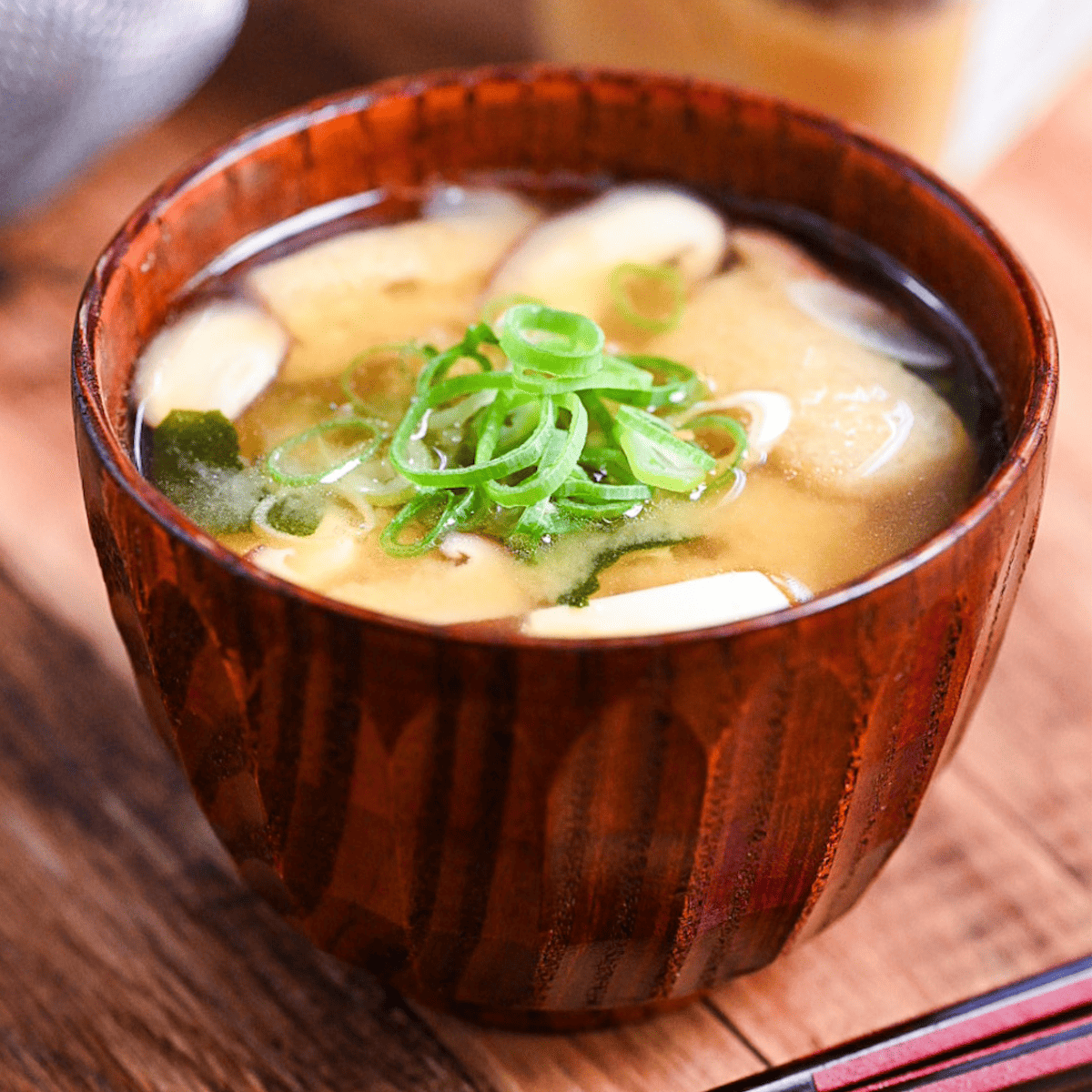
Japanese Miso Soup
Recipe Snapshot
- What is it? Authentic homemade miso soup with handcrafted dashi.
- Flavor profile: Umami-rich, Clean, Comforting
- Why you’ll love this recipe: You’ll master the timeless base of miso soup, then customize it into your own creations.
- Must-haves: Miso paste, Kombu, Bonito Flakes
- Skill Level: Easy
- Suitable for Meal Prep? Yes!
Summarize & Save this content on:
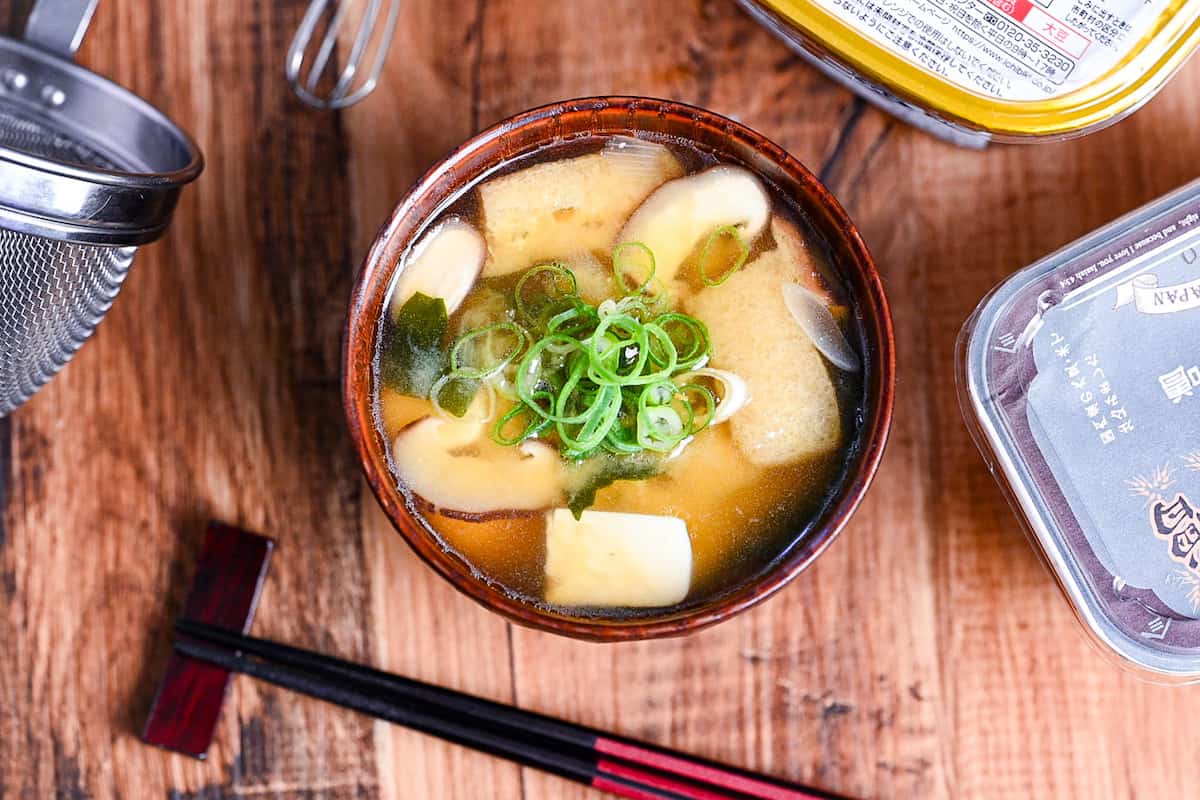
What is Japanese Miso Soup?
Miso soup is one of the cornerstones of Japanese cuisine, made by gently dissolving miso paste into a delicate broth called dashi. On a traditional table, it often sits beside a bowl of steamed Japanese rice, the two forming a perfectly balanced pairing both nutritionally and culturally.
While simple at its core, miso soup has evolved to embrace countless variations across regions and households.
For example, some families prefer the deep, robust flavor of Akadashi, while others enjoy seasonal spins like Clam miso soup or Glass noodle miso soup. For heartier comfort, dishes such as Tonjiru (pork miso soup) or Chicken miso soup add protein-rich depth. And if you’re plant-based, Vegan miso soup offers the same soulful warmth without compromising on authenticity.
Culturally, sipping warm miso soup in the morning is seen as the start of a Japanese day.
Flavor Differences by Type of Miso
Not all miso tastes the same. Depending on the ingredients and fermentation time, miso can range from sweet and delicate to bold and deeply savory. Choosing the right miso makes a big difference in your miso soup’s final flavor.
Here’s a quick guide to the major types and the kinds of ingredients that pair well with them:
| Type of Miso | Flavor Profile | Best with… |
|---|---|---|
Red Miso (Aka / Bean-based, e.g. Hatcho, Sendai) | Rich, salty, earthy, with deep umami and slight bitterness. Stands up well to long cooking. | Hearty ingredients like clams, mushrooms, root vegetables, or pork (perfect for Tonjiru). |
White Miso (Shiro / Rice-based, e.g. Saikyo)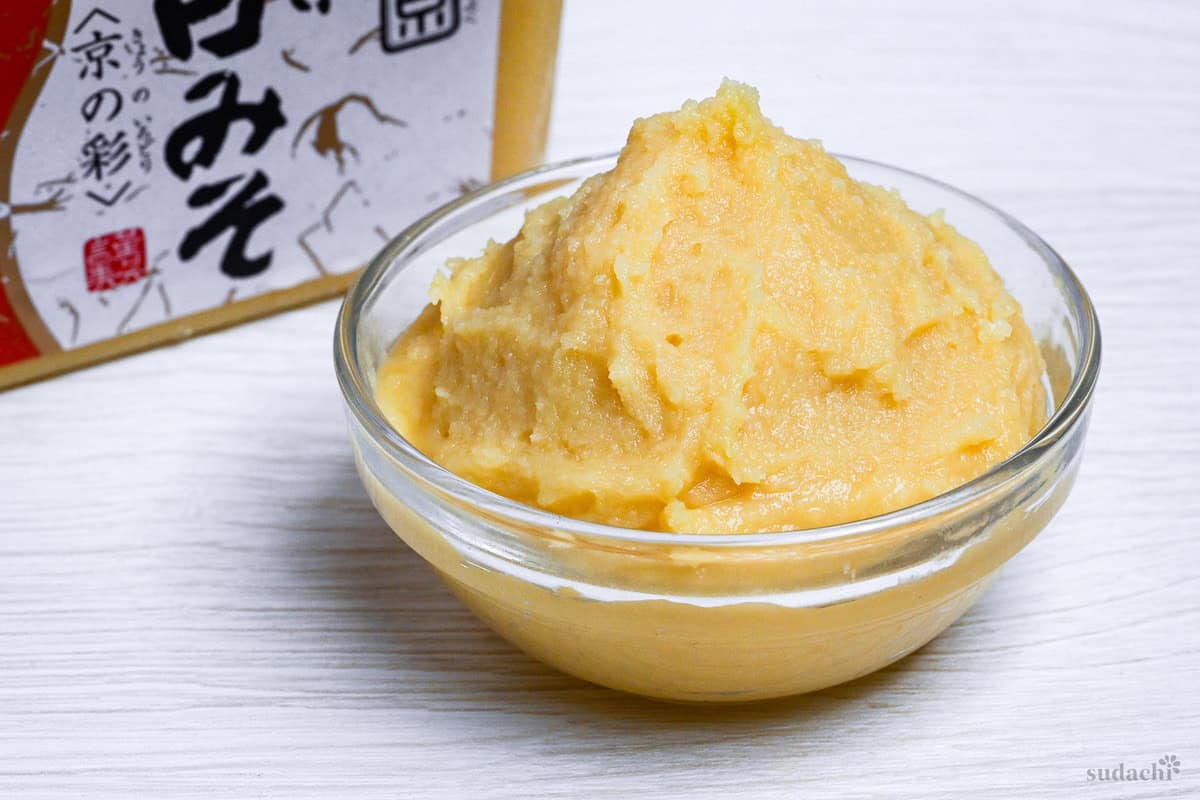 | Mild, naturally sweet, low in salt, with a delicate aroma. | Gentle flavors like turnip, pumpkin, cabbage, or tofu. Also used in Kyoto-style ozoni. |
Blended Miso (Awase / Often referred as yellow in English) | Balanced, versatile, combining sweet and savory elements. | Great all-rounder. Works with almost any ingredient, ideal for beginners. |
| Barley Miso (Mugi) | Light, slightly sweet, with a toasty grain aroma. Common in Kyushu/Shikoku. | Sweet vegetables like sweet potato, pumpkin, or leafy greens for a mellow, homely soup. |
| Regional & Specialty Miso | Wide range: e.g., earthy Hatcho (Tokai), robust Shinshu (Nagano), or unique Okinawan styles. | Depends on the miso. Experimenting with local varieties brings out very different soup personalities. |
As a rule of thumb: red miso loves bold flavors, white miso shines with subtle ones, and blended miso is your safe everyday choice.
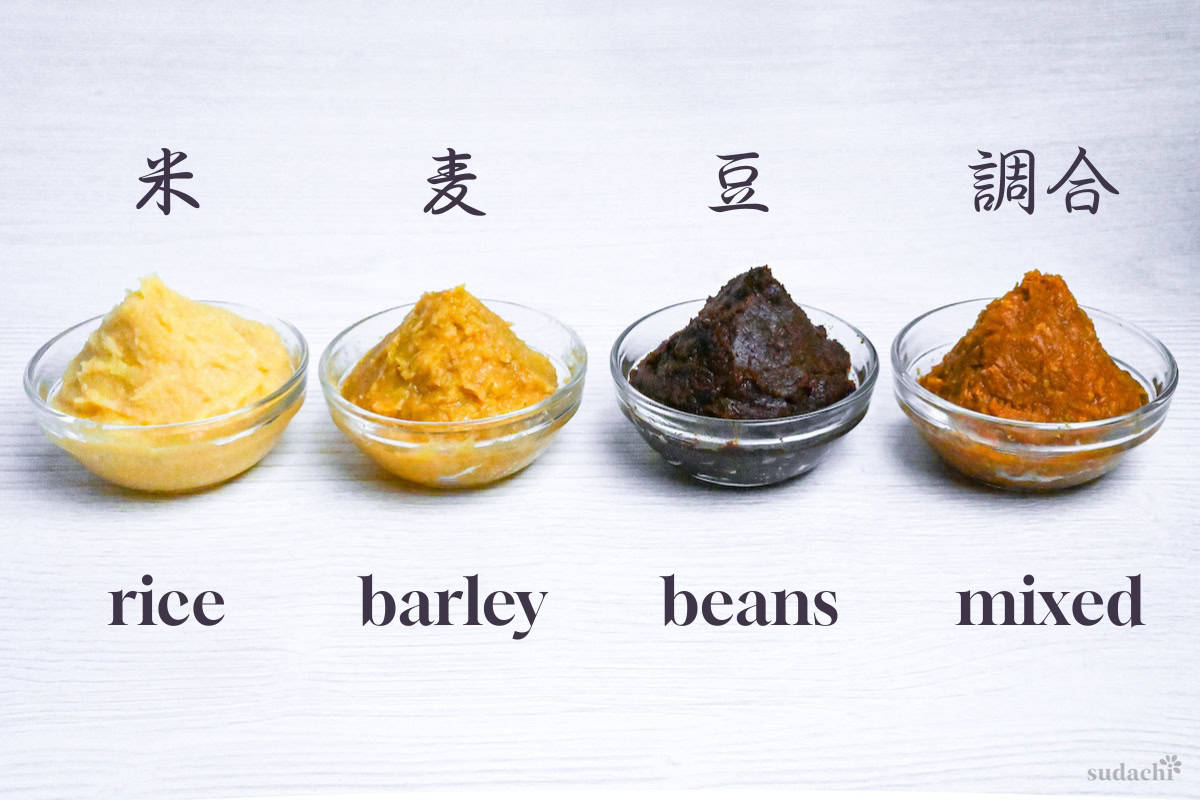
And remember, there are no strict rules, and miso soup is deeply personal. Japanese families often say, “every household has its own miso soup.” Experimenting with different miso types is the best way to discover the flavor that feels most like home to you.
Check out my guide for recommended miso paste brands and deep dive into word of miso!
Authentic Miso Soup Ingredients
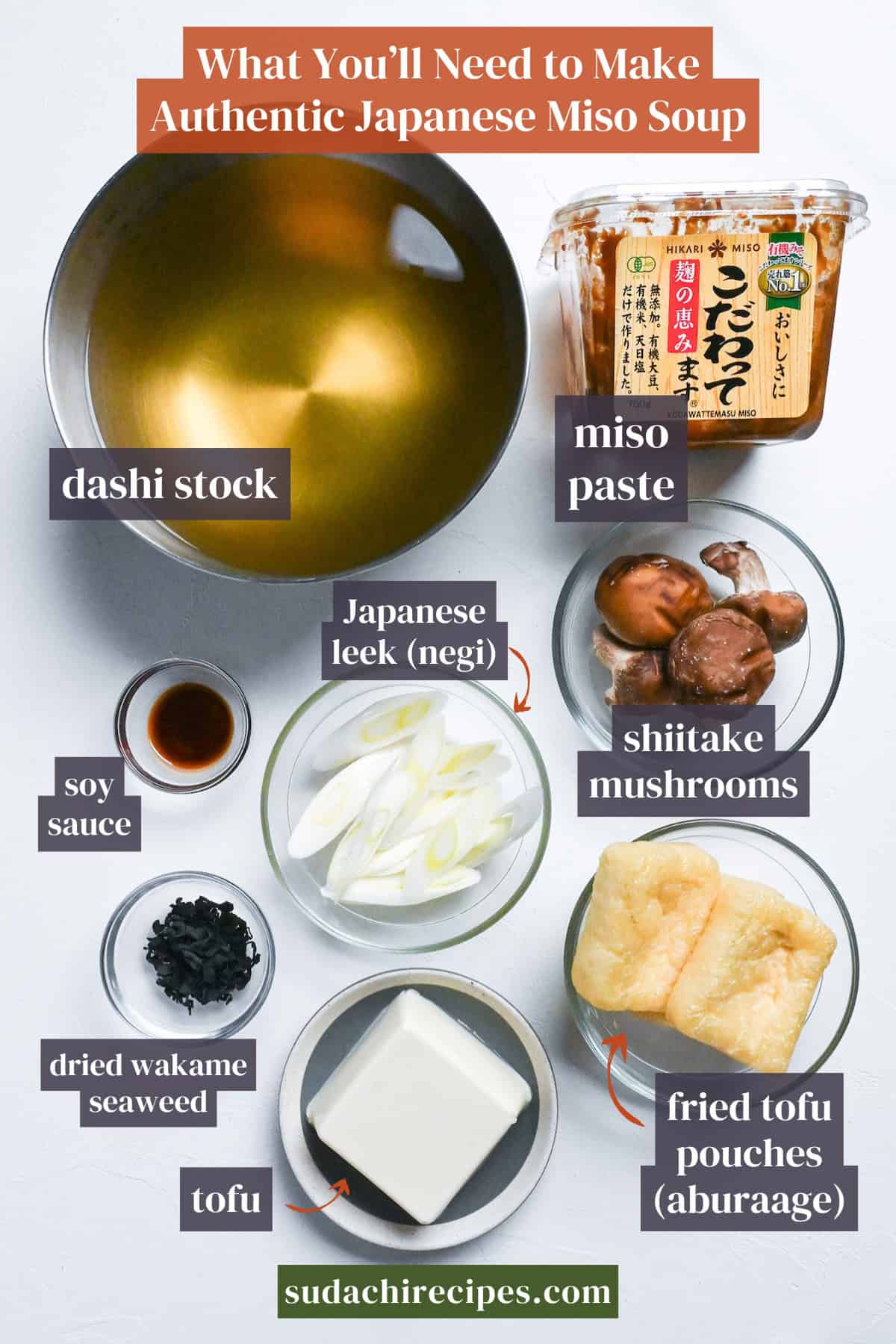
- Dashi stock: Kombu and bonito flakes stock is the backbone of miso soup. You can pick them up at large Asian groceries. For weeknights, I recommend using tea-bag style dashi packet. Instant dashi granules are acceptable. If you want your miso soup to be plant based, you can make vegan dashi with kombu and dried shiitake (less smoky hints, a touch earthier).
- Miso Paste: I recommend using balanced yellow miso if you’re making miso soup for the first time. Check out your local large supermarkets, Asian groceries, or online.
- Ingredients: I use tofu, dried wakame seaweed, aburaage (fried tofu pouches), and Japanese leek for my recipe. I will explain more alternative ideas in the next section!
Five Variation Ideas
The beauty of miso soup lies in its adaptability! Just like how Japanese families customize it with whatever’s fresh and local. Here are five combinations that will help you master this versatile soup while staying true to its seasonal spirit.
| Combination | Why It Works | Local Swaps |
|---|---|---|
Summer Vegetables (Eggplant + Okra)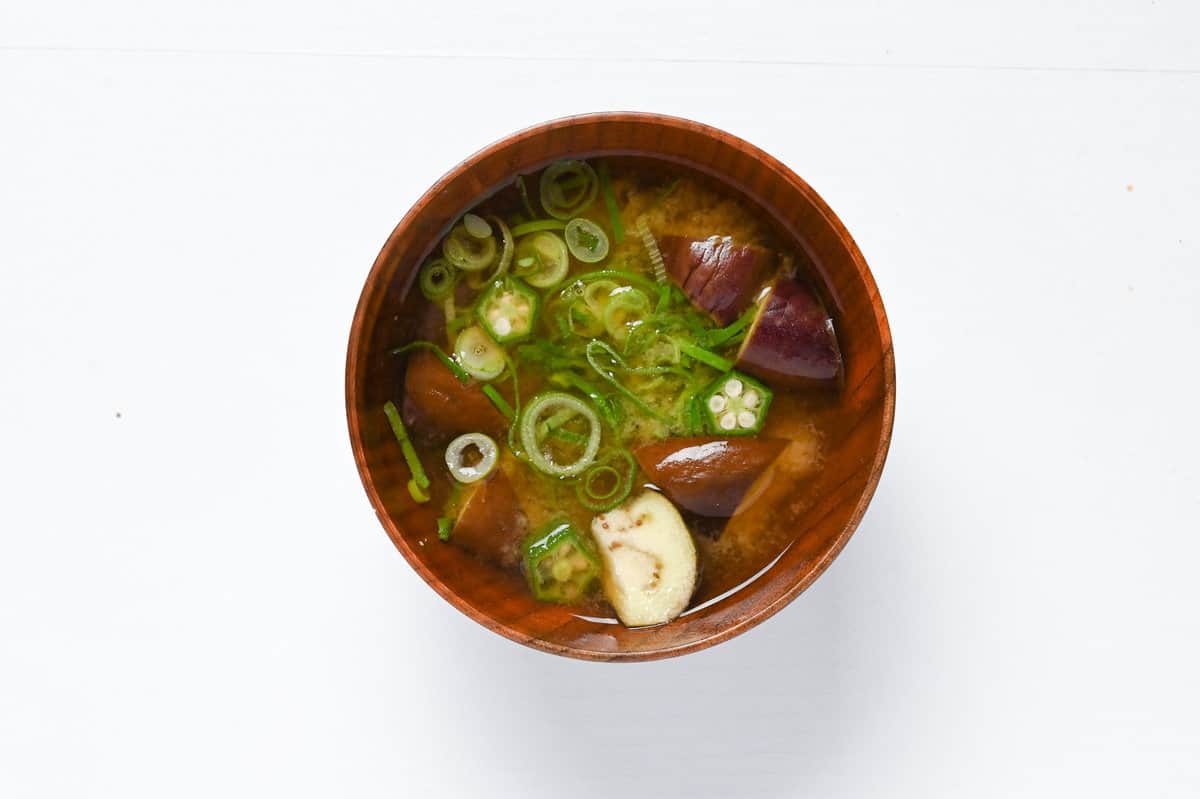 | Eggplant becomes a flavor sponge while okra adds that signature silky thickness | Try zucchini, summer squash, or bell peppers |
Winter Warmth (Napa Cabbage + Aburaage) | Napa cabbage sweetens as it cooks, creating comfort-food vibes | Regular cabbage, bok choy, or hearty winter root vegetables |
Mushroom (Shiitake, enoki, nameko and shimeji)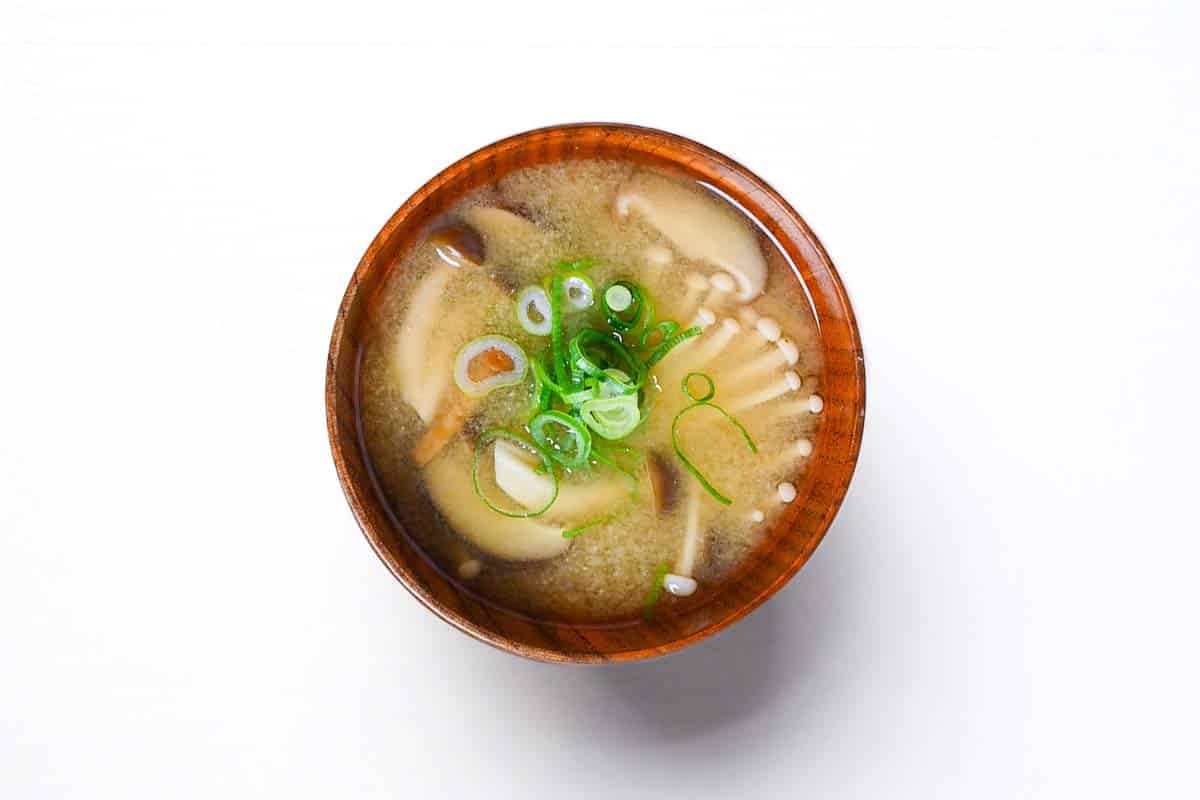 | Can be customized with any of your favorite or local mushrooms to create a unique fall comfort soup | Button, portobello, or maitake mushrooms |
Hearty & Filling (Potato + Onion + Snow Peas)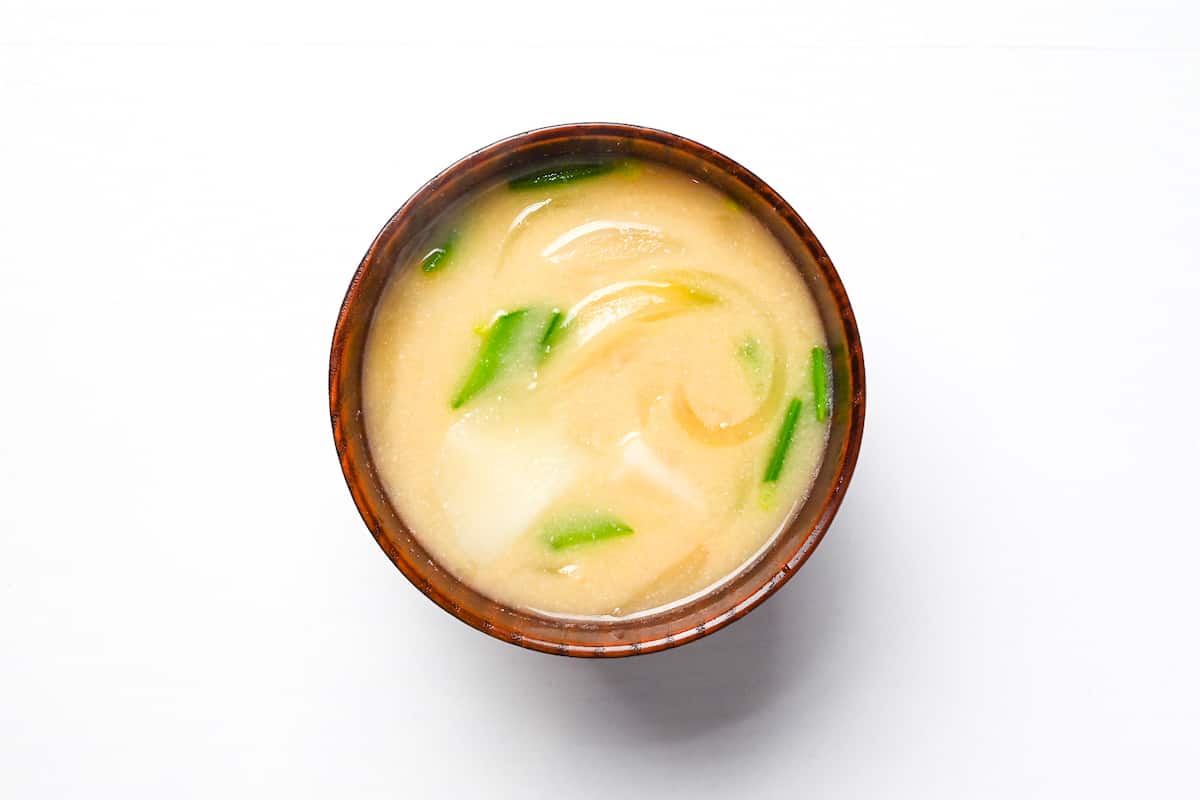 | Potatoes make this soup filling while onions add sweetness | Sweet potatoes, snap peas, or any seasonal root vegetables |
Plant-Based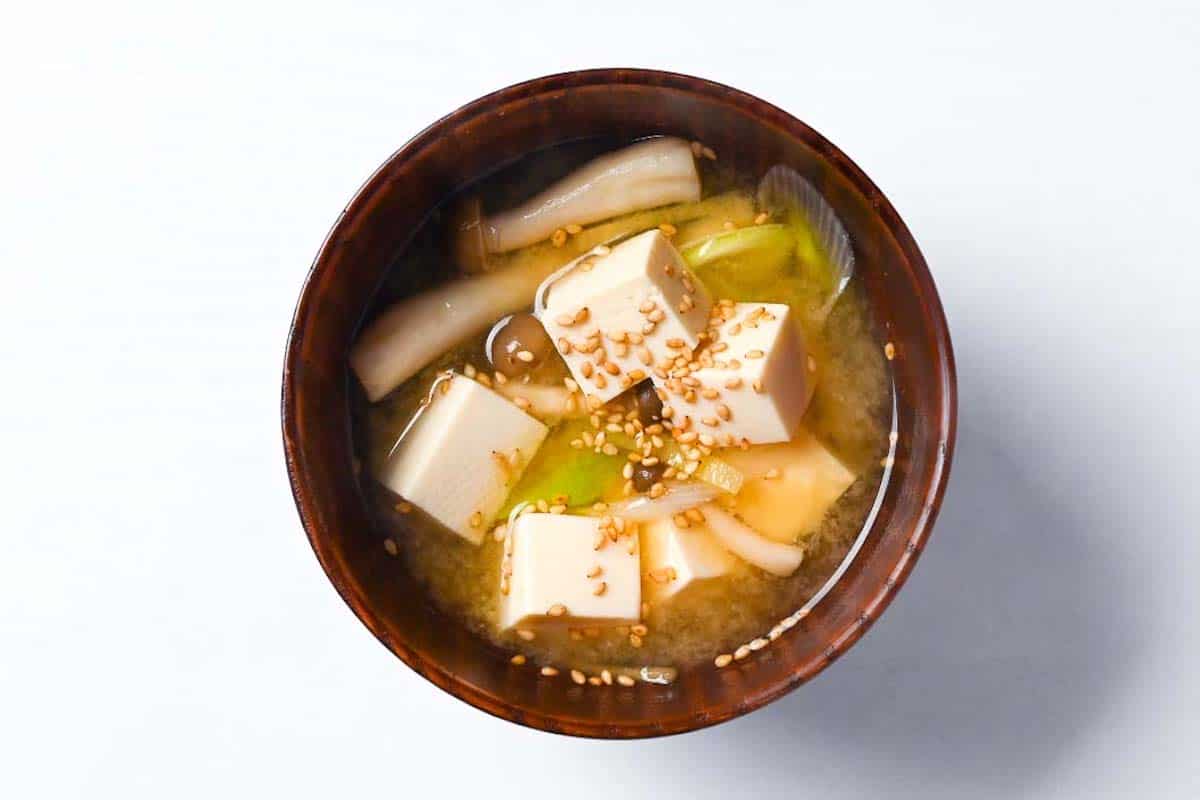 | Make miso soup completely vegan by using dried shiitake and kombu for your dashi base |
Remember, using your local seasonal vegetables is actually more authentic than trying to source hard-to-find Japanese ingredients. The soul of miso soup is about celebrating what’s fresh and available, just like Japanese families do every day.
Have trouble finding Japanese ingredients? Check out my ultimate guide to Japanese ingredient substitutes!
How to Make My Japanese Miso Soup
If you prefer to watch the process in action, check out my YouTube video of this authentic miso soup recipe!
Before you start: Let’s be honest, making homemade dashi isn’t always realistic for busy weeknight dinners. Plenty of us Japanese reach for dashi packets or granules when time is tight. While instant granules work in a pinch, I highly recommend using high-quality dashi packets (tea bag-style). They deliver much better flavor than granules.
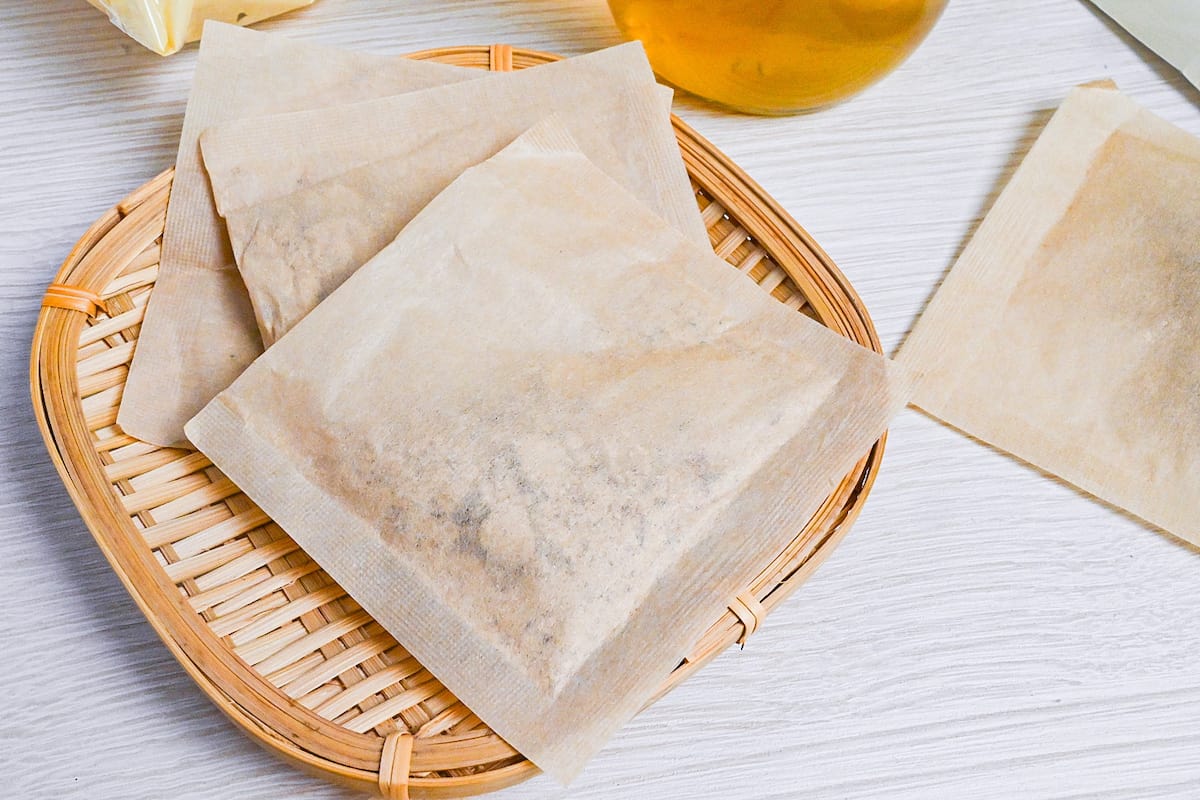
If you are going to use either of these quick options, skip the first step!
i. Drop dried kombu into cold water and let it hydrate 30 minutes (or up to 24 hours, covered in the fridge) to prime it for extraction. A cold soak starts drawing out glutamates before any heat, giving you a head start on savoriness without pulling tannic or slimy notes.

ii. Set the pot over medium-low heat and bring the water almost (but not quite) to a boil. Lift the kombu out just before boiling (around a bare simmer, 90-95℃ (194-203°F)) to avoid extracting bitterness or excess viscosity. Watch for a soft shimmer and tiny bubbles at the pot’s edge as your cue.

Harsh boiling coaxes out off-flavors and cloudiness that distract from delicate aroma. Easy does it yields a clearer, more elegant stock.
iii. To catch the best aroma, drop the temperature to about 80℃ (176°F) with a splash of cold water, then add katsuobushi and steep without stirring until the flakes hydrate and begin to sink (about 3-5 minutes). This lower-heat extraction captures delicate smoky notes without harshness.

iv. Pour the stock through a fine strainer lined with cloth or paper, and let it drain naturally. Do not press on the flakes.

v. Save the spent kombu/flakes for a milder niban dashi if you like (check out my full guide on niban dashi here)
i. Slice aburaage (fried tofu) thinly, cut shiitake and Japanese leek (negi) thin so they soften quickly, and cube silken or firm tofu for a creamy contrast.
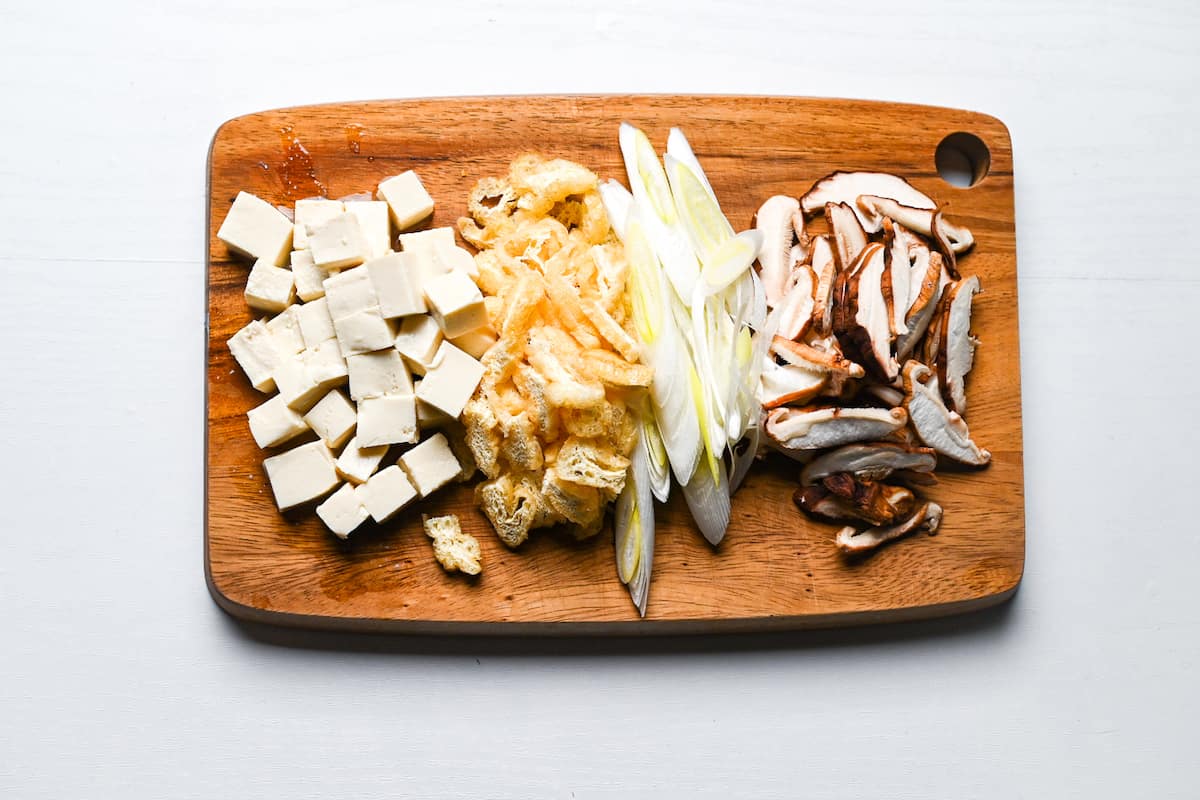
i. Bring your dashi to a gentle simmer and cook the items that need a bit more time (shiitake and aburaage) first until tender.
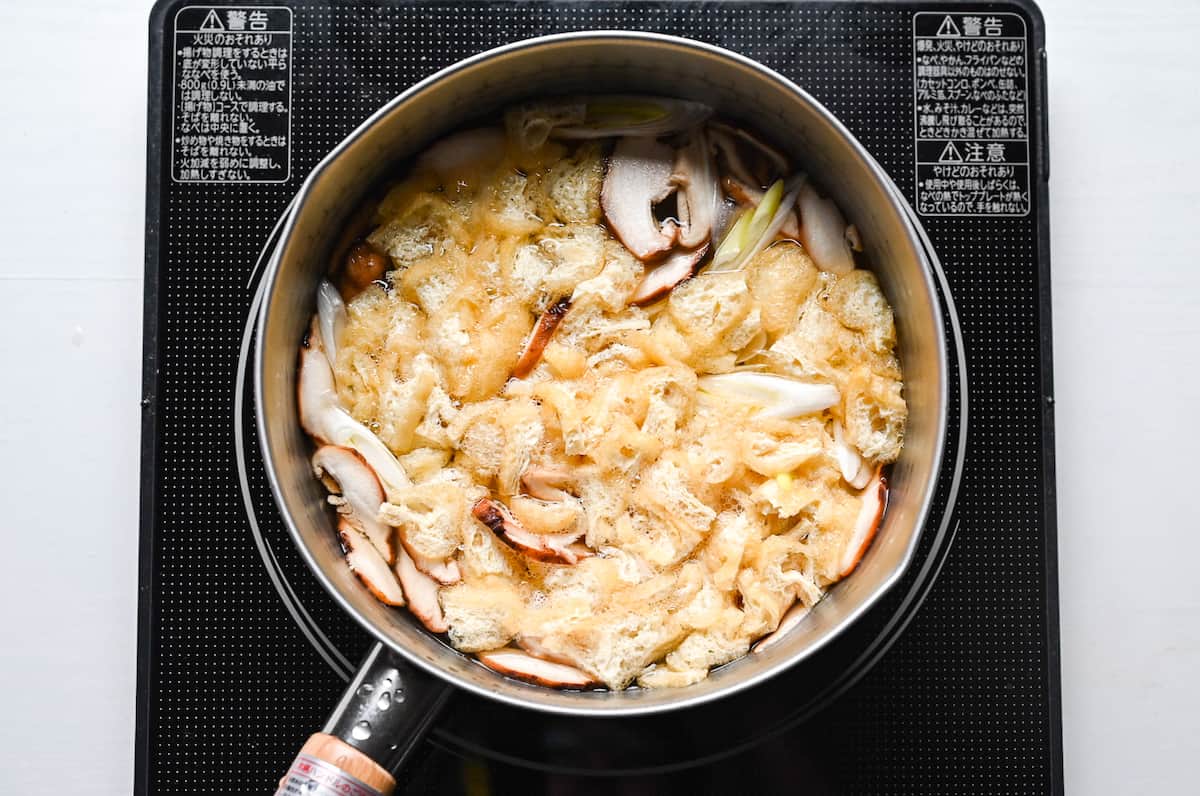
ii. Add dried wakame near the end so it stays vivid and just-tender, and, if you like, I like seasoning the broth with a dash of dark soy for depth before the miso goes in.
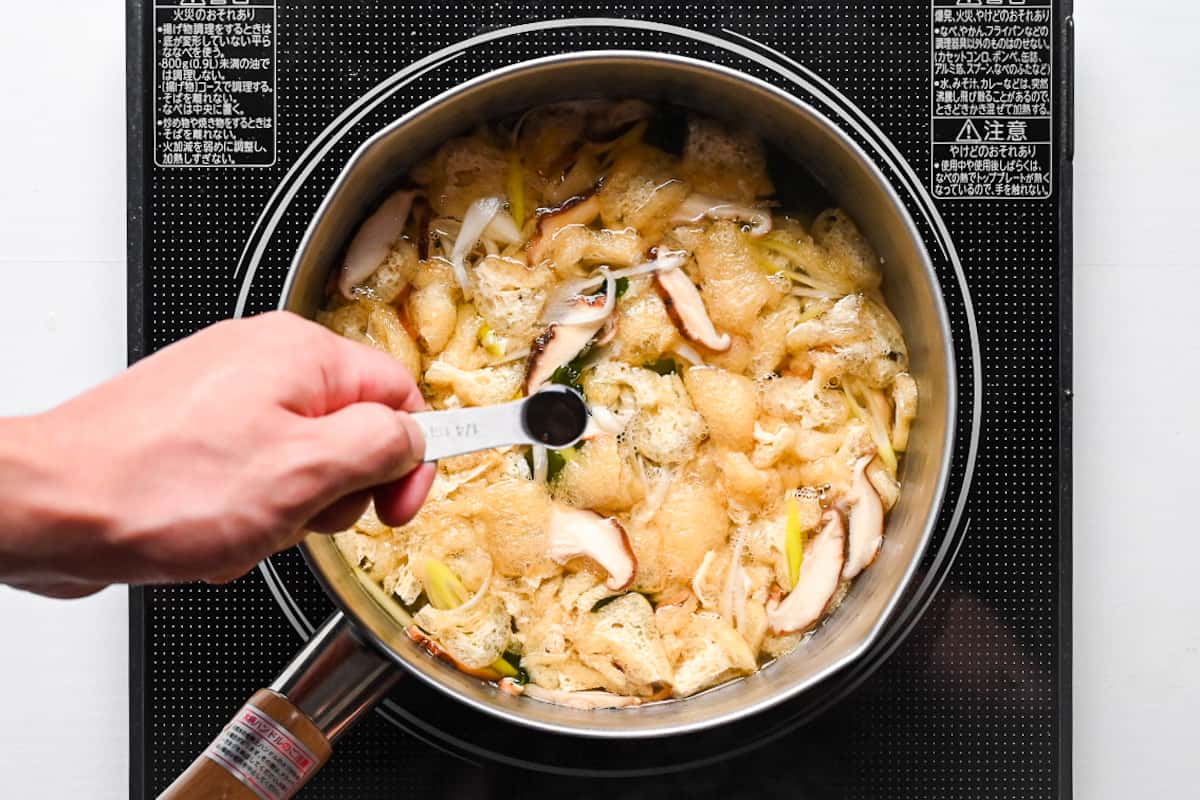
i. Turn off the heat, and add the miso paste using a strainer.
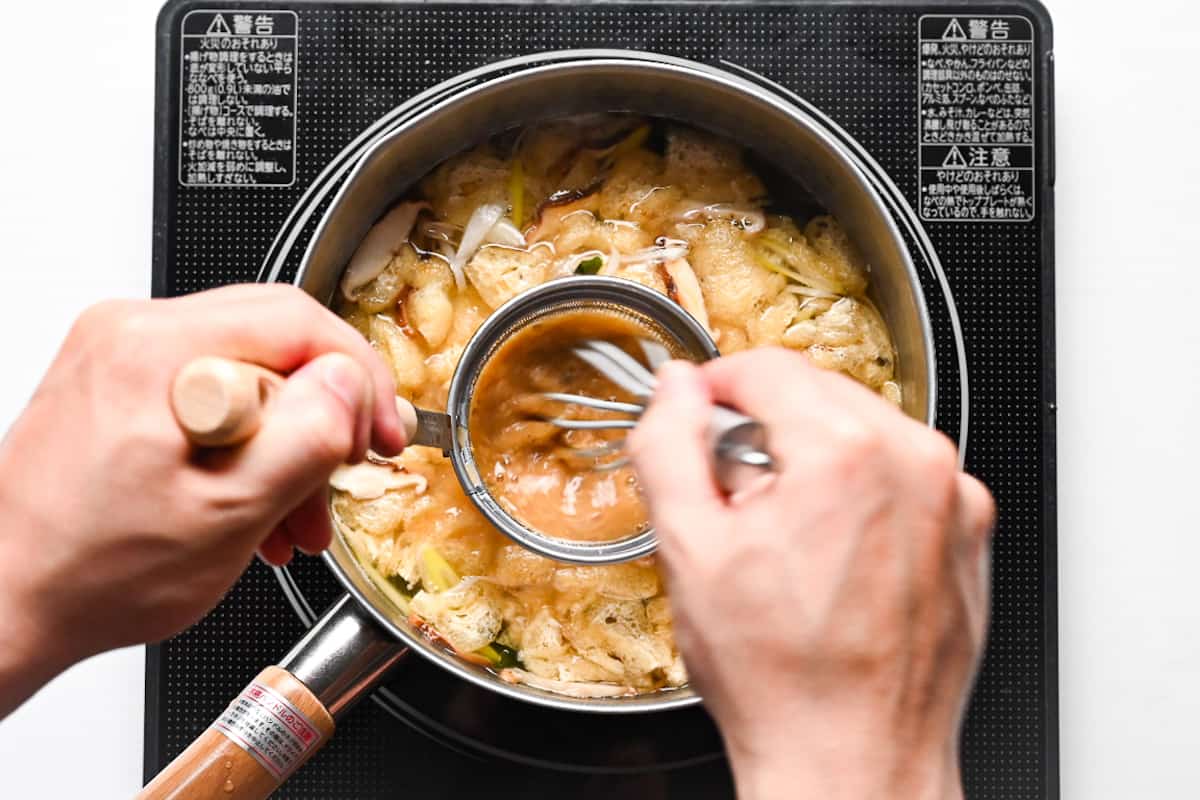
If you add miso paste straight to the broth, it will be difficult to break up and there will be large lumps of miso in your soup. This can also make the overall taste of the soup weaker because the miso paste is not evenly distributed throughout the broth.
I recommend placing the miso paste on a fine mesh spoon and resting the spoon on the surface of the broth so that they come into contact with each other.
The hot broth will soften the paste, allowing you to whisk it while it’s still on the spoon, then it will seep into the broth through the mesh. This will thoroughly break up the paste and allow it evenly distributed throughout the broth.

If you don’t have a mesh spoon, you can also break up the miso paste by placing it in a small heatproof bowl or ladle and whisking it with a few tablespoons of broth. Once it’s smooth, simply pour it back into the pot.

Miso’s signature aroma comes from volatile alcohols and esters created during fermentation. Boiling drives them off, flattening flavor. Add miso at the end and keep the soup below a simmer for maximum fragrance.
ii. Slip in the cubed tofu and warm it gently for 2-3 minutes so it’s heated through without breaking.
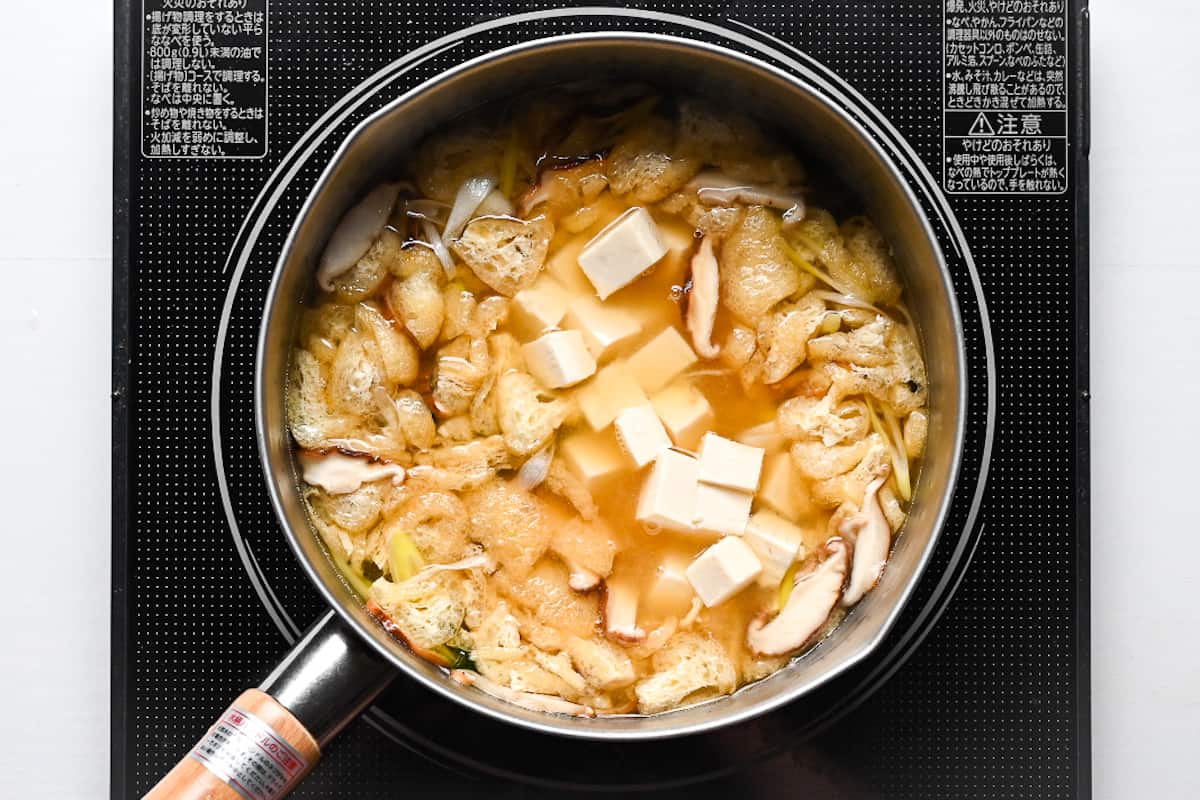
One reason is that tofu is ready to eat straight from the package, so it doesn’t require thorough cooking. Additionally, tofu (especially silken) breaks apart easily, so I add it last and let it warm through with residual heat.
iii. Ladle the soup into bowls, then scatter chopped green onion for a fresh, green top note.
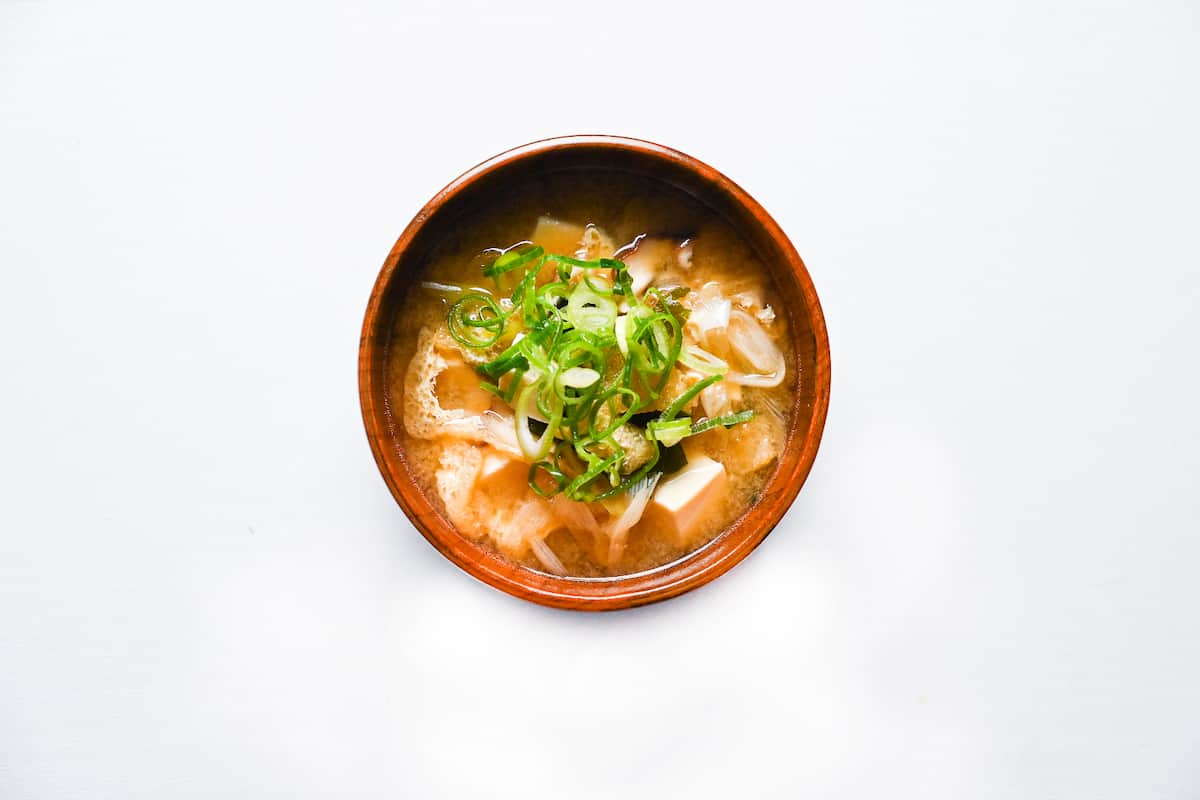

Essential Tips & Tricks
- Add miso off the heat. Boiling can weakens its delicate aroma compounds and flattens flavor.
- Order ingredients by density: root vegetables early, quick-cook items like tofu and greens last.
- Tofu should be added near the end. Stirring too much can break it apart.
- Aim to serve miso soup around 75℃ (167°F). Too hot mutes flavor, too cool makes the saltiness sharper.
- If short on time, quality dashi packs are an authentic shortcut.
With these simple tips in mind, you’re set for success every time you make traditional miso soup.
Storage & Meal Prep
Fridge: Transfer to a shallow, airtight container and chill quickly. Use within 1-2 days. If the soup contains tofu, potatoes, or seafood, aim for within 24 hours.
Freezer: Not recommended
Meal Prep: Make dashi 2-3 days ahead and refrigerate, prep and chill sliced vegetables up to 2 days.
Reheating: Warm on the stovetop or microwave until about 75-80℃ (167-176°F). Do not boil to preserve aroma. Reheat only once, stir well, and if the salt tastes sharper after heating, refresh with a splash of hot water.
What to Serve With This Recipe
- Japanese Grilled Salmon
- Ohitashi Salad
- Shogayaki (Ginger Pork Stir-Fry)
- Pork Tonkatsu
Miso Soup Q&A
Start with a reliable baseline of 15 g miso per 200 ml dashi, then adjust. If it’s too salty, add hot water or dashi to dilute. If too weak, dissolve a little more miso in a ladle and stir in gradually. After reheating, flavors can concentrate, so restore balance with a splash of hot water.
Don’t dump miso straight into the pot. Use a fine strainer or dissolve it in a ladle with hot broth, then mix in. If tiny lumps remain, warm gently and let sit to finish dissolving.
While the main ingredient for miso is soybeans, some miso pastes these days contain extra ingredients to add umami. These ingredients often contain fish products. Miso paste for vegetarians and vegans does exist, but you need to check the packaging to confirm this. Do not assume that all miso paste is suitable for vegans. See my vegan miso soup recipe for more information!
You can reuse the used katsuobushi to make a second batch of dashi once, which we call niban dashi. Although I don’t have a video for that, I have a guide article on how to make the second batch if you’re interested. (https://sudachirecipes.com/katsuobushi/) You can also repurpose used kombu to make kombu rice balls. I have a video for this. (https://www.youtube.com/watch?v=xZcvMyhXRGE)
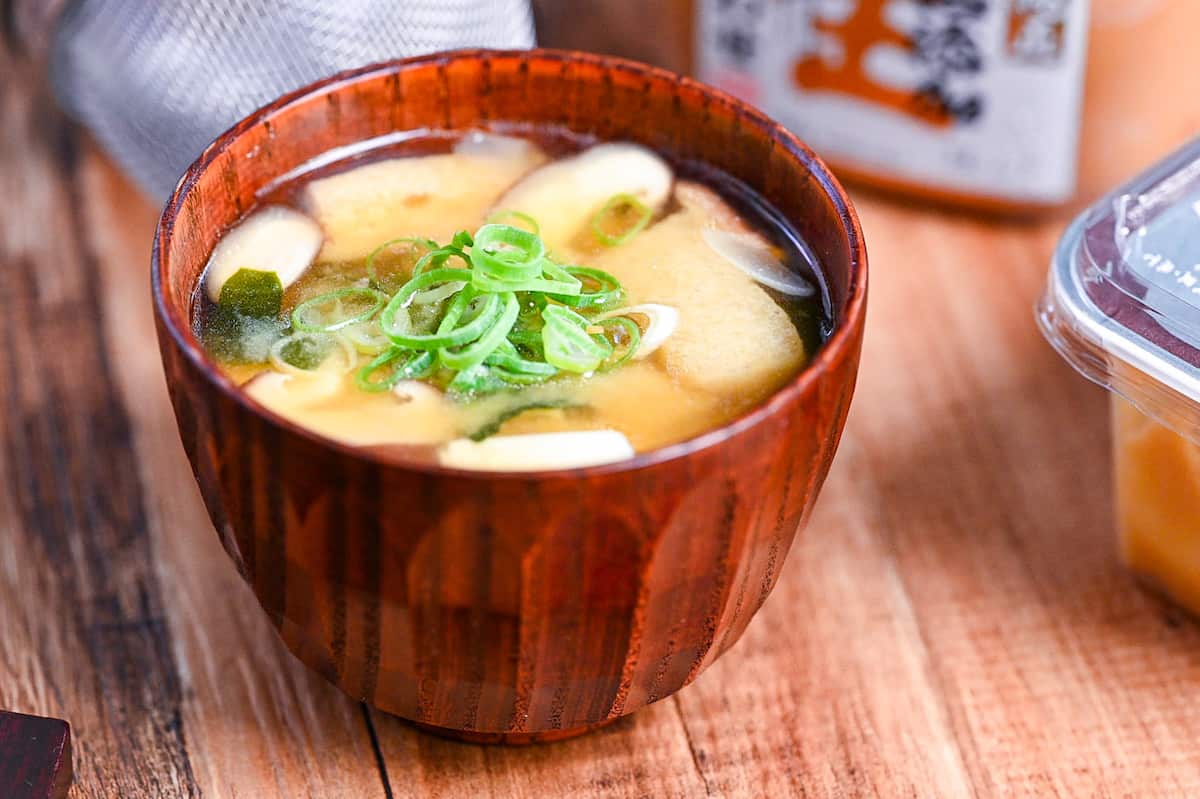
More Miso Paste Recipes
- Easy Miso Ramen
- Miso Glazed Salmon
- Nasu Dengaku (Miso Eggplant)
- Miso Marinated Chicken
Want to make the most of your miso paste? Browse these easy recipes with miso paste!
Did You Try This Recipe?
I would love to hear your thoughts!
💬 Leave a review and ⭐️ rating in the comments below. 📷 I also love to see your photos – submit them here!

Traditional Miso Soup (Authentic Japanese Method)
Equipment
Ingredients
Homemade Dashi
- 5-10 g dried kelp (kombu)
- 1 liter cold water
- 100 ml cold water to lower temp before adding bonito
- 2 handfuls bonito flakes (katsuobushi) approx 1 cup per handful
Miso Soup
- 150 g tofu silken = creamy, firm = holds shape,
- 30 g fried tofu pouch (aburaage)
- 30 g Japanese leek (naganegi)
- 30 g fresh shiitake mushroom cremini ok in pinch
- 1 tbsp dried wakame seaweed
- ¼ tsp Japanese soy sauce (koikuchi shoyu) or tamari for GF
- 4 tbsp yellow miso paste (awase) or mix 50/50 white and red miso
- finely chopped green onions optional garnish
My recommended brands of ingredients and seasonings can be found in my Japanese pantry guide.
Can’t find certain Japanese ingredients? See my substitution guide here.
Instructions
Making Dashi (skip if using dashi shortcut)
- Add 5-10 g dried kelp (kombu) and 1 liter cold water to a large pot and soak for at least 30 minutes (up to 24hrs covered in the fridge).

- Once rehydrated, place the pot on the stove and bring to a simmer over a medium-low heat. Be careful not to let it boil. When small bubbles start to appear (90-95℃ (194-203°F)), remove the kombu. Discard it or save it for another recipe.

- Continue to heat until boiling, then turn off the burner and add 100 ml cold water. Drop 2 handfuls bonito flakes (katsuobushi) into the pot and steep for 3-5 minutes without stirring.

- Line a sieve with kitchen paper and place it over a large heatproof bowl.

- Pour the dashi through the sieve, the kitchen paper will catch the small pieces of katsuobushi, leaving you with a clear broth.

Making Miso Soup
- Thinly slice 30 g fried tofu pouch (aburaage), 30 g Japanese leek (naganegi) and 30 g fresh shiitake mushroom. Cut 150 g tofu into cubes.

- Pour the dashi into a pot and heat on medium. Once it's almost boiling, add the ingredients that take longer to cook (aburaage, leek, shiitake) and simmer for a few minutes until cooked to your liking.

- Turn off the heat and stir in ¼ tsp Japanese soy sauce (koikuchi shoyu).

- Scoop 4 tbsp yellow miso paste (awase) onto a mesh spoon or ladle. Dip the miso paste into the dashi and whisk it in the spoon to loosen it up. Keep whisking, gradually allowing more dashi to seep into the mesh spoon/ladle each time until the miso paste has dissolved into the mixture.

- Add 150 g tofu (cubed) to the hot miso soup and stir gently. Allow to warm on residual heat for 2-3 minutes.

- Divide the miso soup into bowls and garnish with finely finely chopped green onions. Serve and enjoy!

Video






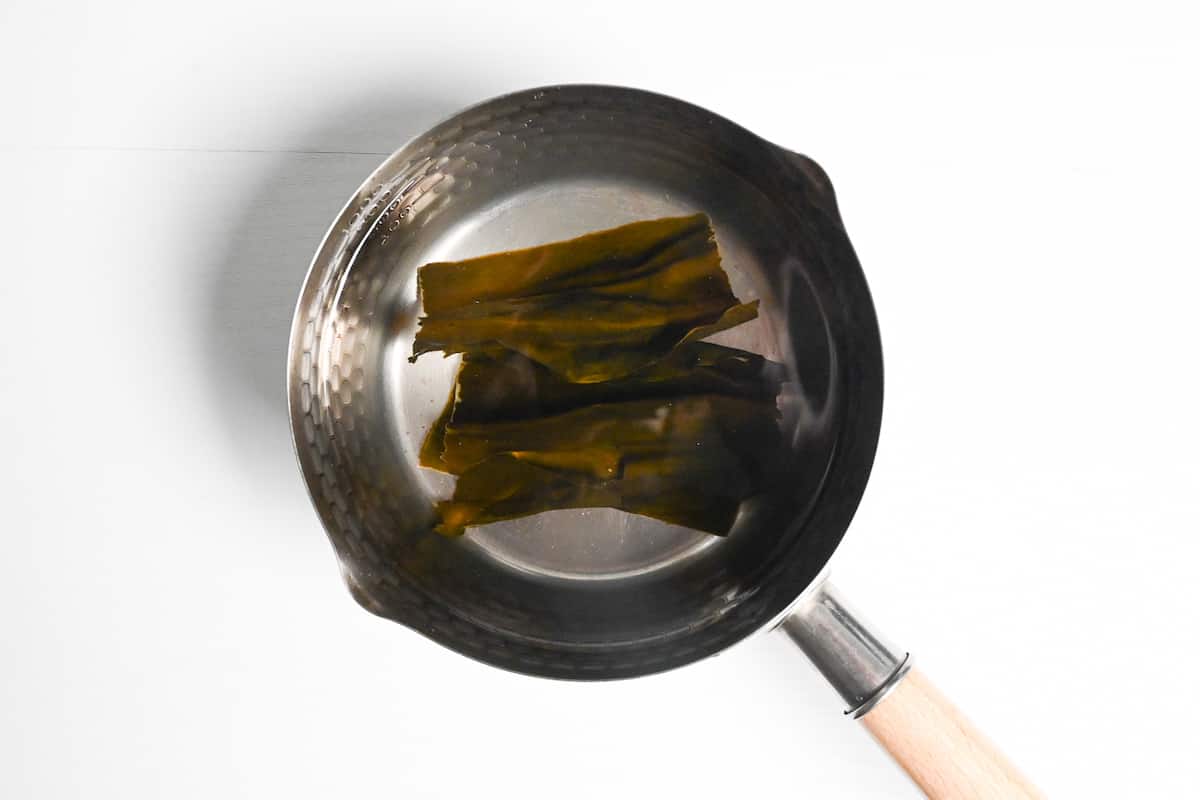
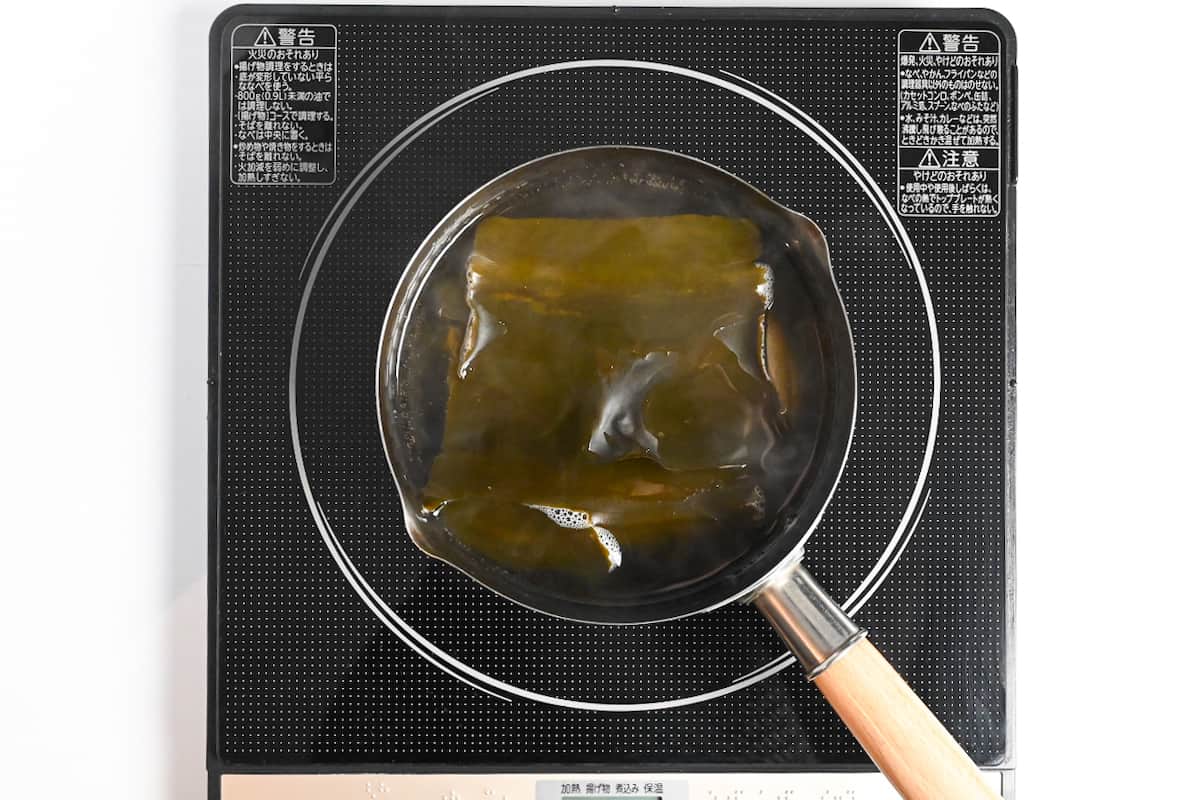
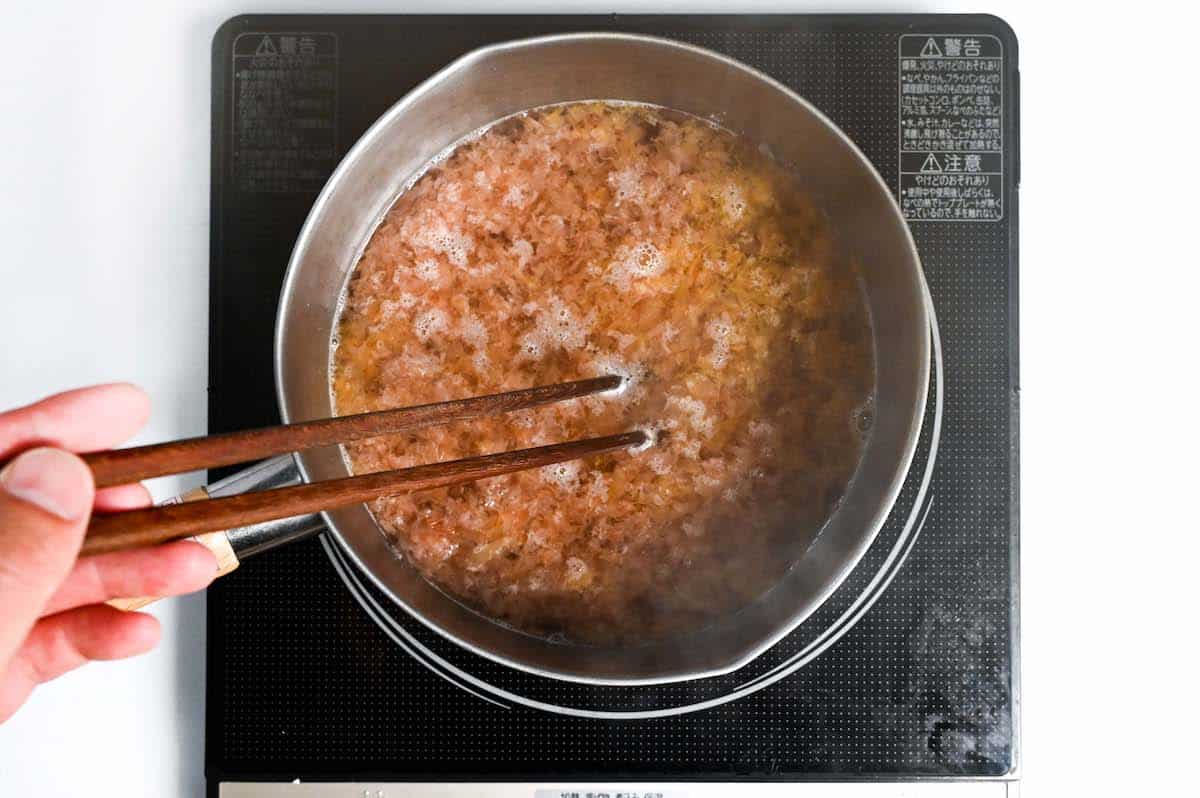

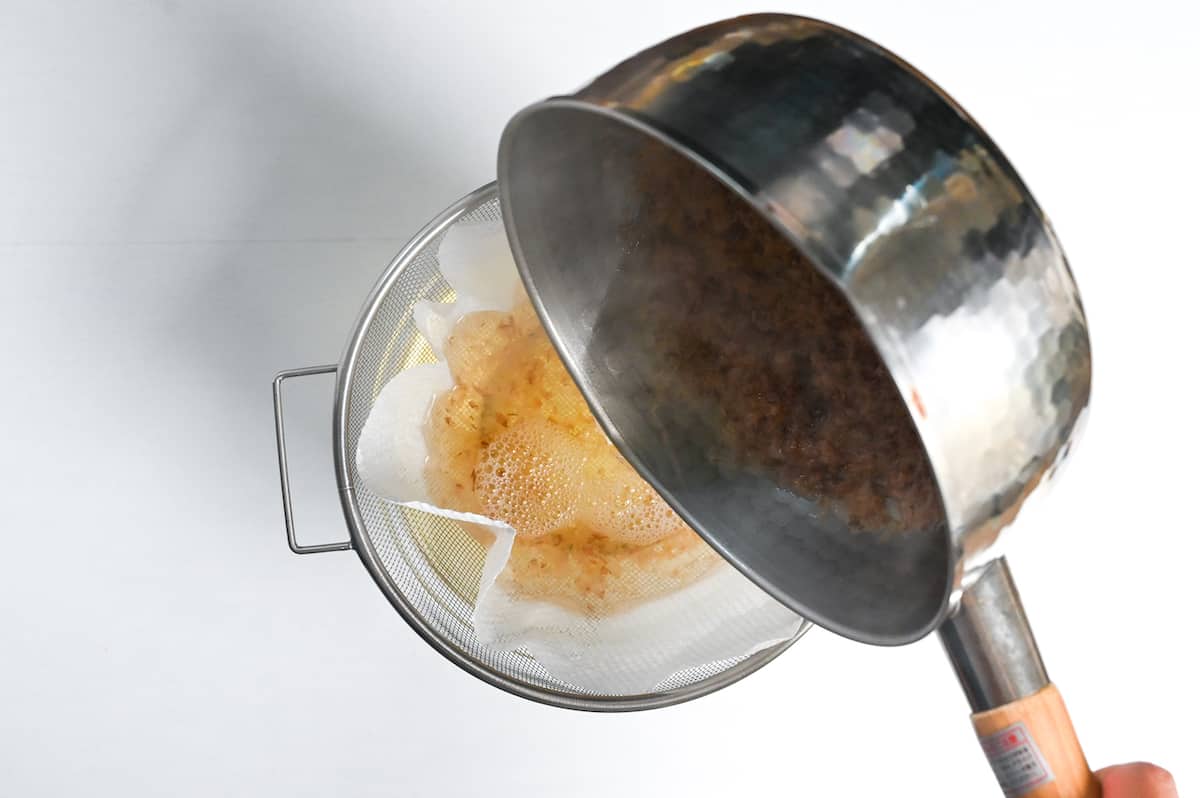
This was wonderful, thank you.
Thank you Kiki, glad you enjoyed it!
Alot of your recipes are like my mother’s but she passed away. I didn’t get most of her recipes. I didn’t know she would leave me so soon. I’m glad you are here to show me some of your recipes. Thank you, Niomi
Hi Niomi,
I’m really sorry to hear about your mother. I’m glad I could help with my recipes. Let me know if there’s anything in particular you’d like recipes for anytime!
Yuto
Hi – thank you for this very helpful recipe. After Step 4 there is something green in the soup. What is that?
It’s my pleasure! 🙂
The green bits after step 4 are pieces of wakame, a type of seaweed commonly added to miso soup. It’s an optional ingredient though.
Hope that helps, thanks for stopping by!
Hii ,
which color of miso did you use and which Kombu did you use? Thank you 🙂
Hi mimi,
Thank you for the comment!
Typically, I opt for Awase (mixed) Miso, often referred to as “yellow miso” in English.
As for Kombu, my choice usually varies based on what I have in my pantry. However, Rishiri and Hidaka kombu are frequent picks for my miso soup.
If you’re curious about the various types of kombu and their unique characteristics, you can check out our ‘Kombu 101‘ post.
I hope this response is helpful to you!
Yuto
Dear Sir. Because of your accent I could follow the name of the ingredients. Many thanks
Hi Martha,
Thank you for the comment!
I’m glad to hear that my video was helpful!
Yuto
This Authentic Homemade Japanese Miso Soup is amazing! I made it twice and my family loves it! A definite keeper, thank you for sharing and for the detailed instructions!
Hi Lisa,
Thank you so much for trying this recipe! I’m glad to hear you and your family enjoyed it! 🙂
Yuto
Your Authentic Homemade Japanese Miso Soup.
Hello,
I make it twice a month and it’s delicious. I follow your recipe to the letter. The ingredient I love most on this recipe is aburaage. Thank you so much for your replies to my queries.
Manuela
Hi Manuela,
Thank you so much for making my miso soup recipe regularly! I’m happy to hear you enjoy it and that you appreciate the aburaage – it certainly adds such a wonderful flavor dimension! 🙂
Yuto
Best miso recipes
Thank you, Tomasz!
Delicious and worth the effort. I have followed the recipe twice so far. However, I added the tofu before the miso. I add the tofu, let it heat through. Then I turn off the heat and wait a minute before stirring the miso through a seive. Some people say this helps with preserving the probiotics in the miso. Not sure if it’s true. Thank you for the detailed video.
Hi Gal,
Thank you so much for your kind words and trying this recipe twice already! I’m happy to hear that you enjoyed it! 🙂
Yuto
I just hope I can make it as delicious as yours looks! Thank you so much
Hi Vanessa,
I’m sure it will! I hope you will enjoy making it! 🙂
Yuto